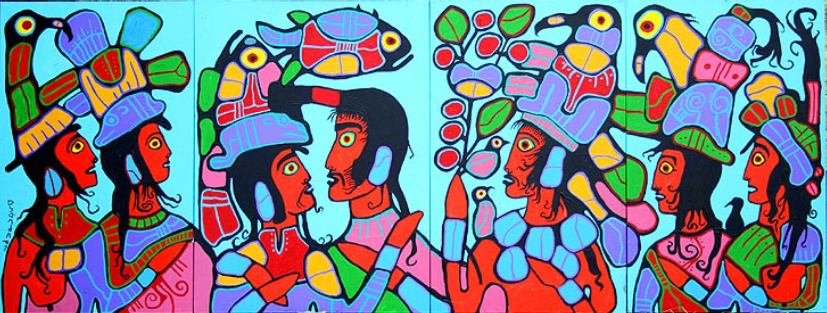When Art Transcends Controversy: the Norval Morrisseau Legacy
 Even in death, the saga of legendary Ojibway artist Norval Morrisseau has been embroiled in dispute.
Even in death, the saga of legendary Ojibway artist Norval Morrisseau has been embroiled in dispute.
It began shortly after he died in December of 2007, when his seven children battled with his former handler and business manager to have his remains buried next to their mother in Keewaywin, Ontario instead of cremated. Now, his children are filing a lawsuit against the same man — Gabor Michael Vadas — over the execution of his will. They believe the will was created under suspicious circumstances given Morrisseau’s weak physical and mental state in the years up to his death and they want the rights to his name and images.
While it ultimately makes sense for his family to preserve his artistic and cultural legacy, Morrisseau’s art itself continues to shine immortal despite these controversies. Even in an often troubled life, his paintings captured Anishinaabe traditions in a truly unique way that we will continue to learn from for generations to come.

Most Canadians are familiar with his incomparable images. What started as more rustic and stripped-down interpretations of Anishinaabe life and culture blossomed into vibrant, epic pieces that are as just as recognizable to people who aren’t art aficionados. He created not only trademark shapes and images, but also expressive narratives. He could tell a story in a painting few artists can – from the creation story to showing the coexistence of all beings on Mother Earth to the lessons one learns in becoming a shaman. He shot to fame in the 1960s as the “Picasso of the North”, touring Europe with members of the “Indian Group of Seven” and being regaled in his home country as a genius. But with that came the stereotypical downfalls of fame – drug and alcohol abuse, blown fortunes, and brief jail time.
Through all of this, Morrisseau’s art and dedication to telling his people’s stories persevered. People in the arts community from coast to coast have stories about him. There are the legends of him sketching original pieces on bar napkins and tables to pay his tab. Countless imitators have emerged over the years, many of whom have been outed as impostors and scam artists. Because of his grand scope and geographic reach, there are also tales of hidden caches of original paintings yet to be found. He painted until he was no longer physically able to. And in 2006, he was honoured as the first Aboriginal artist to be solely exhibited in the National Art Gallery of Canada. Because of this monumental artistic and cultural legacy, it’s no wonder his children want to make sure it’s maintained properly. And as long as we can all see his work, he’ll always be one of the most important Aboriginal figures this continent has ever known.
*UPDATE: a reader identified the painting originally embedded in this post as a fake. We’ve changed it.

